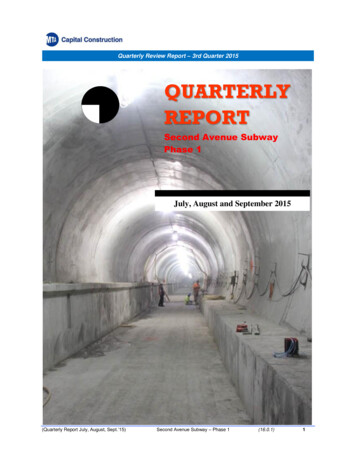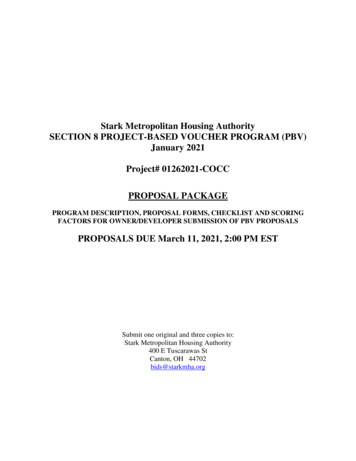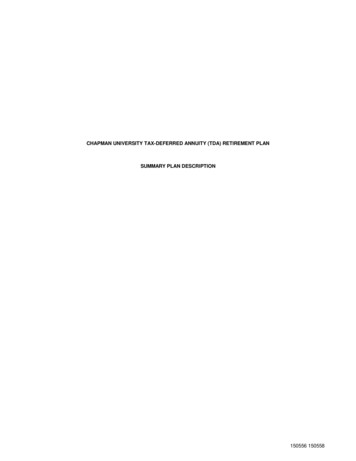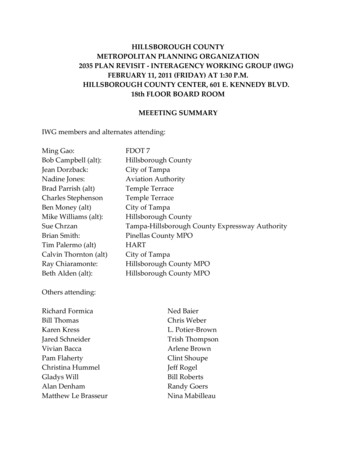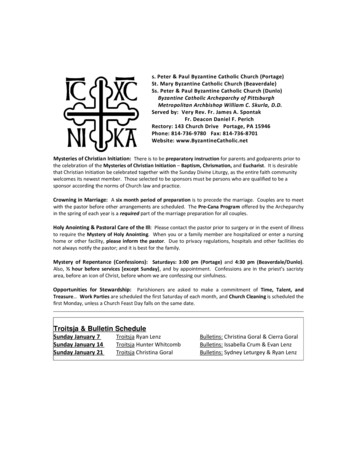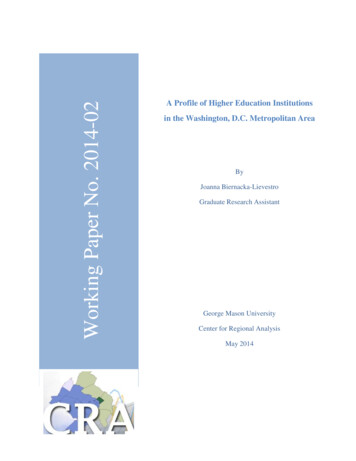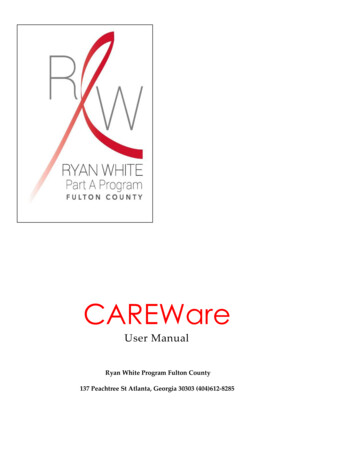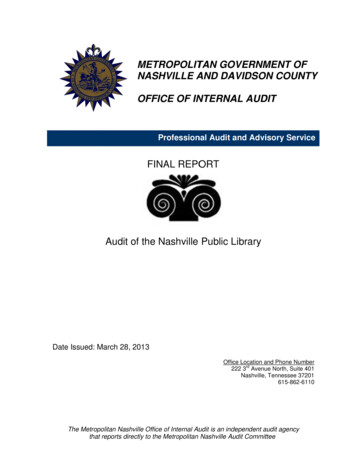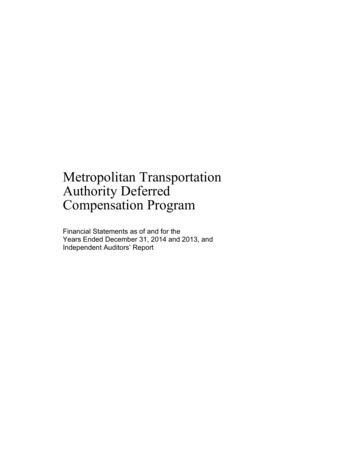
Transcription
Metropolitan TransportationAuthority DeferredCompensation ProgramFinancial Statements as of and for theYears Ended December 31, 2014 and 2013, andIndependent Auditors’ Report
METROPOLITAN TRANSPORTATION AUTHORITYDEFERRED COMPENSATION PROGRAMTABLE OF CONTENTSPageINDEPENDENT AUDITORS’ REPORT1-2MANAGEMENT’S DISCUSSION AND ANALYSIS (UNAUDITED)3-22FINANCIAL STATEMENTSStatements of Plans Net Position as of December 31, 2014 and 201323Statements of Changes in Plans Net Position for theYears Ended December 31, 2014 and 201324Notes to Financial Statements25-45
Deloitte & Touche LLP30 Rockefeller PlazaNew York, NY 10112-0015USATel: 1 212 492 4000Fax: 1 212 492 5000www.deloitte.comINDEPENDENT AUDITORS’ REPORTTo the Committee of theMetropolitan Transportation Authority Deferred Compensation ProgramReport on the Financial StatementsWe have audited the accompanying statements of Plans net position of the Metropolitan TransportationAuthority Deferred Compensation Program, comprised of the Deferred Compensation Plans for Employeesof the Metropolitan Transportation Authority, its Subsidiaries and Affiliates and the Thrift Plan forEmployees of the Metropolitan Transportation Authority, its Subsidiaries and Affiliates, (collectively the“Plans”) as of December 31, 2014 and 2013, and the related statements of changes in Plans net position forthe years then ended, and the related notes to the financial statements, which collectively comprise thePlans’ basic financial statements as listed in the table of contents.Management’s Responsibility for the Financial StatementsManagement is responsible for the preparation and fair presentation of these financial statements inaccordance with accounting principles generally accepted in the United States of America; this includes thedesign, implementation, and maintenance of internal control relevant to the preparation and fair presentationof financial statements that are free from material misstatement, whether due to fraud or error.Auditors’ ResponsibilityOur responsibility is to express an opinion on these financial statements based on our audits. We conductedour audits in accordance with auditing standards generally accepted in the United States of America. Thosestandards require that we plan and perform the audits to obtain reasonable assurance about whether thefinancial statements are free from material misstatement.An audit involves performing procedures to obtain audit evidence about the amounts and disclosures in thefinancial statements. The procedures selected depend on the auditor's judgment, including the assessmentof the risks of material misstatement of the financial statements, whether due to fraud or error. In makingthose risk assessments, the auditor considers internal control relevant to the Plans’ preparation and fairpresentation of the financial statements in order to design audit procedures that are appropriate in thecircumstances, but not for the purpose of expressing an opinion on the effectiveness of the Plans’ internalcontrol. Accordingly, we express no such opinion. An audit also includes evaluating the appropriateness ofaccounting policies used and the reasonableness of significant accounting estimates made by management,as well as evaluating the overall presentation of the financial statements.We believe that the audit evidence we have obtained is sufficient and appropriate to provide a basis for ouraudit opinions.Member ofDeloitte Touche Tohmatsu
OpinionIn our opinion, the financial statements referred to above present fairly, in all material respects, the Plans’net position as of December 31, 2014 and 2013, and the respective changes in Plans’ net position for theyears then ended in accordance with accounting principles generally accepted in the United States ofAmerica.Other MattersRequired Supplementary InformationAccounting principles generally accepted in the United States of America require that the Management’sDiscussion and Analysis on pages 3 through 22 be presented to supplement the basic financial statements.Such information, although not a part of the basic financial statements is required by the GovernmentalAccounting Standards Board who considers it to be an essential part of financial reporting for placing thebasic financial statements in an appropriate operational, economic, or historical context. We have appliedcertain limited procedures to the required supplementary information in accordance with auditing standardsgenerally accepted in the United States of America, which consisted of inquiries of management about themethods of preparing the information and comparing the information for consistency with management’sresponses to our inquiries, the basic financial statements, and other knowledge we obtained during our auditof the basic financial statements. We do not express an opinion or provide any assurance on the informationbecause the limited procedures do not provide us with sufficient evidence to express an opinion or provideany assurance.January 25, 2016-2-
METROPOLITAN TRANSPORTATION AUTHORITYDEFERRED COMPENSATION PROGRAMMANAGEMENT’S DISCUSSION AND ANALYSISDECEMBER 31, 2014 AND 2013The Deferred Compensation Program is comprised of the Deferred Compensation Plans for Employees ofthe Metropolitan Transportation Authority, its Subsidiaries and Affiliates (“457 Plan”) and the Thrift Planfor Employees of the Metropolitan Transportation Authority, its Subsidiaries and Affiliates (“401(k) Plan”),collectively known as the “Plans” and the “Metropolitan Transportation Authority Deferred CompensationPlans”. This management’s discussion and analysis of the Plans’ financial performance provides anoverview of the Plans’ financial activities for the years ended December 31, 2014 and 2013. It is meant toassist the reader in understanding the Plans’ financial statements by providing an overall review of thefinancial activities during the year and the effects of significant changes. This discussion and analysis maycontain opinions, assumptions, or conclusions by the MTA’s management that should not be considered areplacement for, and is intended to be read in conjunction with the Plans’ financial statements which beginon page 23.OVERVIEW OF BASIC FINANCIAL STATEMENTSThe following discussion and analysis is intended to serve as an introduction to the financial statements.The basic financial statements are: The Statement of Plans Net Position — presents the financial position of the Plans at fiscal year end.It provides information about the nature and amounts of resources with present service capacity thatthe Plan presently controls (assets), consumption of net assets by the Plan that is applicable to a futurereporting period (deferred outflow of resources), present obligations to sacrifice resources that the Planhas little or no discretion to avoid (liabilities), and acquisition of net assets by the Plan that is applicableto a future reporting period (deferred inflow of resources) with the difference between assets/deferredoutflow of resources and liabilities/deferred inflow of resources being reported as net position.Investments are shown at fair value. All other assets and liabilities are determined on an accrual basis. The Statements of Changes in Plans Net Position present the results of activities during the year. Allchanges affecting the assets and liabilities of the Plans are reflected on an accrual basis when the activityoccurred regardless of the timing of the related cash flows. In that regard, changes in the fair values ofinvestments are included in the year’s activity as net appreciation (depreciation) in fair value ofinvestments. The Notes to Financial Statements provide additional information that is essential to a fullunderstanding of the data provided in the financial statements. The notes present information about thePlans’ accounting policies, significant account balances and activities, material risks, obligations,contingencies, and subsequent events, if any.The financial statements are prepared in accordance with GASB Pronouncements.Financial HighlightsAs a result of various Deferred Compensation Program changes, expanding participant eligibility throughcollective bargaining, a strong educational program and greater participant satisfaction, the DeferredCompensation Program has continued to grow. The assets of the 457 Plan exceeded its liabilities by 2.011billion and the assets of the 401(k) plan exceeded its liabilities by 2.756 billion as of December 31, 2014.This net position is held in trust for distribution to the Plans participants and/or beneficiaries.-3-
The assets of the 457 Plan exceeded its liabilities by 1.815 billion and the assets of the 401(k) planexceeded its liabilities by 2.491 billion as of December 31, 2013. This net position is held in trust fordistribution to the Plans participants and/or beneficiaries.During 2014, the net positions held in trust for the 457 Plan and the 401(k) Plan increased by 195.933 million and 265.703 million respectively due primarily to net investment income and employerand employee contributions to the plans. This was offset by distributions to participants and plan expenses.During 2013, the net positions held in trust for the 457 Plan and the 401(k) Plan increased by 278.814 million and 380.305 million respectively due primarily to net investment income and employerand employee contributions to the plans. This was offset by distributions to participants and plan expenses.Deductions from the Plans’ net position consist primarily of distributions to participant and transfers toother plans, and plan expenses in the amounts of 93.311 million and 76.193 million for the 457 Plan and 119.305 million and 110.965 million for the 401(k) Plan for the year ended December 31, 2014 and 2013,respectively.Plans Net PositionAs of December 31,( In Thousands)457 PlanAmount of Change(2014 (2013 2013)2012)2012Percentage Change(2014 (2013 2013)2012)20142013 1,949,962 .8%18.2%ASSETS:Investments at fair value:Participant loans receivableTotal assets1,484,329 190,833 LIABILITIES:Administrative expensereimbursementTotal liabilitiesTOTAL NET POSITION 2,010,745 1,814,812 1,535,998 401K Plan20142013195,933 Amount of Change(2014 (2013 2013)2012)2012Percentage Change(2014 (2013 2013)2012)ASSETS:Investments at fair value:Participant loans receivableTotal assets 2,637,807 2,379,654 2,009,694 258,153 8.0LIABILITIES:Administrative expensereimbursementTotal 10.7%18.0%TOTAL NET POSITIONHELD IN TRUST 2,756,380 2,490,677 2,111,372 -4-265,703
Changes in Plans Net PositionFor the Years Ended December 31,( In Thousands)457 Plan2014ADDITIONS:Investment income:Contributions andadditional depositsLoan repayments - interestTotal additions DEDUCTIONS:Distribution to participantsTransfers to other plansNet participant loan activityOtherIncrease in net position20132012Amount of Change(2014 (2013 2013)2012)Percentage Change(2014 (2013 2013)2012)211,663 108,827 (127,335) 52(82,881)105,862(29.7)61.2172,952278,81418.210.8 %12.718.2 %84,328 TOTAL NET POSITION HELD IN TRUSTBeginning of year1,814,812End of year 2,010,745 1,535,9981,814,812 1,363,046278,8141,535,998 195,933 3,0098,256(2,214)269,077401K Plan201420132012Amount of Change(2014 (2013 2013)2012)Percentage Change(2014 (2013 2013)2012)ADDITIONS:Investment income:Contributions andadditional depositsLoan repayments - interestTotal additionsDEDUCTIONS:Distribution to participantsTransfers to other plansNet participant loan activityOtherIncrease in net position 118,282 303,221 156,543 (184,939) 4,5391,26285,006265,703379,305243,790TOTAL NET POSITION HELD IN TRUSTBeginning of year2,490,677End of year 2,756,380 2,111,3722,490,677 02)1,867,582379,3052,111,372 265,703 61.0% 18.010.7 %13.118.0 %9,23819,079(2,667)30925,959
Investment OptionsThe MTA Plans offer ten (10) Target Lifecycle Funds which provide a diversified mix of the Plans’ investmentoptions and allow a participant to choose the fund closest to the withdrawal date. The Target-Year LifecycleFunds are designed to provide a complete asset allocation strategy appropriate for an individual’s risk and returnpreferences in a single fund through a diversified portfolio of the Plans’ domestic stock funds, internationalstock funds and fixed income funds. Allocations are automatically rebalanced to their targets on a quarterlybasis.Fund NameAsset ClassPortfolio AllocationsMTA Target-Year Lifecycle 2010 FundLarge Cap 9%Mid Cap 2%Small Cap 2%International 8%Market Bonds 15%Stable Value 43%TIPS 21%MTA Large Cap Core Index Fund 3%MTA Large Cap Value Portfolio 3%MTA Large Cap Growth Portfolio 3%MTA Mid Cap Core Portfolio 2%MTA Small Cap Core Portfolio 2%MTA International Portfolio 8%MTA Bond Core Plus Portfolio 15%MTA Stable Value Fund 43%MTA TIPS 21%MTA Target-Year Lifecycle 2015 FundLarge Cap 9%Mid Cap 4%Small Cap 4%International 10%Market Bonds 17%Stable Value 36%TIPS 20%MTA Large Cap Core Index Fund 5%MTA Large Cap Value Portfolio 2%MTA Large Cap Growth Portfolio 2%MTA Mid Cap Core Portfolio 4%MTA Small Cap Core Portfolio 4%MTA International Portfolio 10%MTA Bond Core Plus Portfolio 17%MTA Stable Value Fund 36%MTA TIPS 20%MTA Target-Year Lifecycle 2020 FundLarge Cap 13%Mid Cap 4%Small Cap 4%International 14%Market Bonds 20%Stable Value 28%TIPS 17%MTA Large Cap Core Index Fund 7%MTA Large Cap Value Portfolio 3%MTA Large Cap Growth Portfolio 3%MTA Mid Cap Core Portfolio 4%MTA Small Cap Core Portfolio 4%MTA International Portfolio 14%MTA Bond Core Plus Portfolio 20%MTA Stable Value Fund 28%MTA TIPS 17%MTA Target-Year Lifecycle 2025 FundLarge Cap 18%Mid Cap 6%Small Cap 6%International 18%Market Bonds 23%Stable Value 15%TIPS 14%MTA Large Cap Core Index Fund 10%MTA Large Cap Value Portfolio 4%MTA Large Cap Growth Portfolio 4%MTA Mid Cap Core Portfolio 6%MTA Small Cap Core Portfolio 6%MTA International Portfolio 18%MTA Bond Core Plus Portfolio 23%MTA Stable Value Fund 15%MTA TIPS 14%-6-
Fund NameAsset ClassPortfolio AllocationsMTA Target-Year Lifecycle 2030 FundLarge Cap 20%Mid Cap 6%Small Cap 6%International 21%Market Bonds 27%Stable Value 8%TIPS 12%MTA Large Cap Core Index Fund 10%MTA Large Cap Value Portfolio 5%MTA Large Cap Growth Portfolio 5%MTA Mid Cap Core Portfolio 6%MTA Small Cap Core Portfolio 6%MTA International Portfolio 21%MTA Bond Core Plus Portfolio 27%MTA Stable Value Fund 8%MTA TIPS 12%MTA Target-Year Lifecycle 2035 FundLarge Cap 22%Mid Cap 7%Small Cap 6%International 24%Market Bonds 30%TIPS 11%MTA Large Cap Core Index Fund 12%MTA Large Cap Value Portfolio 5%MTA Large Cap Growth Portfolio 5%MTA Mid Cap Core Portfolio 7%MTA Small Cap Core Portfolio 6%MTA International Portfolio 24%MTA Bond Core Plus Portfolio 30%MTA TIPS 11%MTA Target-Year Lifecycle 2040 FundLarge Cap 28%Mid Cap 8%Small Cap 8%International 28%Market Bonds 28%MTA Large Cap Core Index Fund 14%MTA Large Cap Value Portfolio 7%MTA Large Cap Growth Portfolio 7%MTA Mid Cap Core Portfolio 8%MTA Small Cap Core Portfolio 8%MTA International Portfolio 28%MTA Bond Core Plus Portfolio 28%MTA Target-Year Lifecycle 2045 FundLarge Cap 31%Mid Cap 10%Small Cap 10%International 34%Market Bonds 15%MTA Large Cap Core Index Fund 15%MTA Large Cap Value Portfolio 8%MTA Large Cap Growth Portfolio 8%MTA Mid Cap Core Portfolio 10%MTA Small Cap Core Portfolio 10%MTA International Portfolio 34%MTA Bond Core Plus Portfolio 15%MTA Target-Year Lifecycle 2050 FundLarge Cap 33%Mid Cap 10%Small Cap 10%International 36%Market Bonds 11%MTA Large Cap Core Index Fund 11%MTA Large Cap Value Portfolio 11%MTA Large Cap Growth Portfolio 11%MTA Mid Cap Core Portfolio 10%MTA Small Cap Core Portfolio 10%MTA International Portfolio 36%MTA Bond Core Plus Portfolio 11%MTA Income FundLarge Cap 5%Mid Cap 2%Small Cap 2%International 6%Market Bonds 12%Stable Value 50%TIPS 23%MTA Large Cap Core Index Fund 1%MTA Large Cap Value Portfolio 2%MTA Large Cap Growth Portfolio 2%MTA Mid Cap Core Portfolio 2%MTA Small Cap Core Portfolio 2%MTA International Portfolio 6%MTA Bond Core Plus Portfolio 12%MTA Stable Value Fund 50%MTA TIPS 23%In addition to the ten target year lifecycle funds, the Plans offer a spectrum of investment options that includetwo international funds, two small company stock funds, two mid-size company stock funds, three largecompany stock funds, two bond funds, and the Stable Income Fund (“Fixed Investment Option”).-7-
Core Investment OptionsPotential ReturnInternational Stock FundsSmall Company Stock FundsMid-Sized Company Stock FundLarge Company Stock FundBond FundsFixed Investment OptionPotential RiskThe investment objective for each of the funds is described below. Additional information on each investmentoption, including a Fund Fact Sheet is available on the plans’ website at www.Prudential.com/MTA.International Equity FundsMTA International Index Fund – The fund invests wholly in State Street Global Advisors (“SSgA”) GlobalAll Cap Equity ex U.S. Index Fund – Class C. The fund seeks to match as closely as possible, before expenses,the performance of the MSCI ACWI ex-USA Index over the long term.MTA International Portfolio – The Portfolio is managed by two complementary, but independent managers.The balances in the investments are rebalanced regularly to maintain the 50/50 split. By employing twomanagers, this portfolio offers improved diversification compared to having a single investment manager. Theunderlying investments are:1. William Blair Institutional International Growth Fund – (Foreign Large Growth) The fund seekslong-term capital appreciation. The fund normally invests at least 80% of total assets in a diversifiedportfolio of equity securities, including common stocks and other forms of equity investments, issuedby companies of all sizes domiciled outside the U.S. that the Advisor believes have above-averagegrowth, profitability and quality characteristics. Its investments are normally allocated among at leastsix different countries and no more than 50% of the fund’s equity holdings may be invested in securitiesof issuers in one country at any given time.2. Target International Equity Q Fund – (Foreign Large Blend) The fund seeks capital appreciation.The fund is advised by Prudential Investments LLC and normally invests at least 80% of investableassets in stocks of companies in diverse array of foreign countries. It may invest in large, mid or smallcapitalization companies. The fund may invest in securities of companies that are organized under thelaws of a foreign country, companies that derive more than 50% of their revenues from activities inforeign countries, and companies that have at least 50% of their assets located abroad.Small-Cap Equity FundsMTA Small Cap Core Index Fund – (Small Cap Blend) The fund invests wholly in the SSgA Russell 2000Index Non-Lending Series Fund – Class A. The SSgA Fund seeks an investment return that approximates asclosely as practicable, before expenses, the performance of the Russell 2000 Index over the long term.MTA Small Cap Core Portfolio – The Portfolio is managed by two complementary, b
401k plan 2014 2013 2012 (2014 - 2013) (2013 - 2012) (2014 - 2013) (2013 - 2012) . metropolitan transportation authority deferred compensation program. metropolitan transportation authority deferred com
